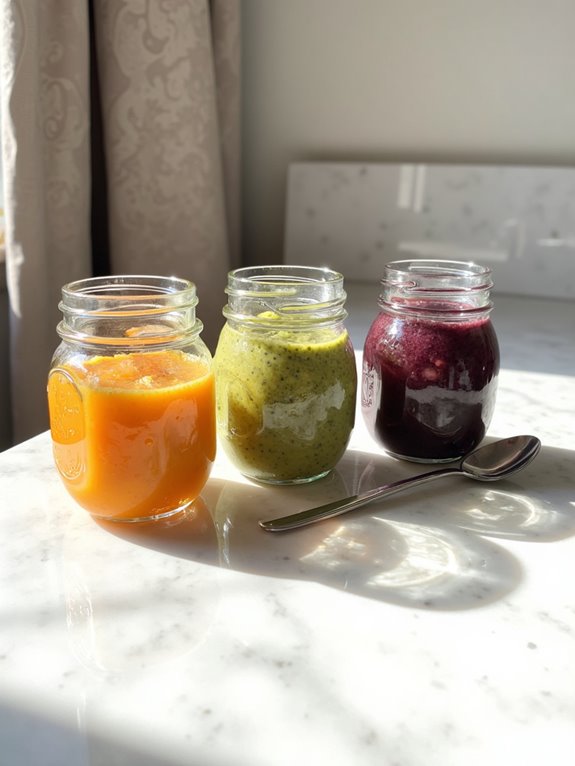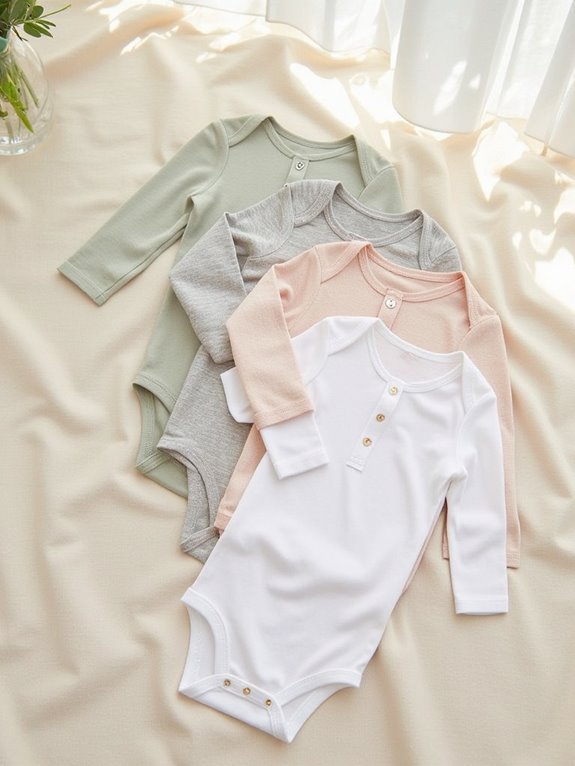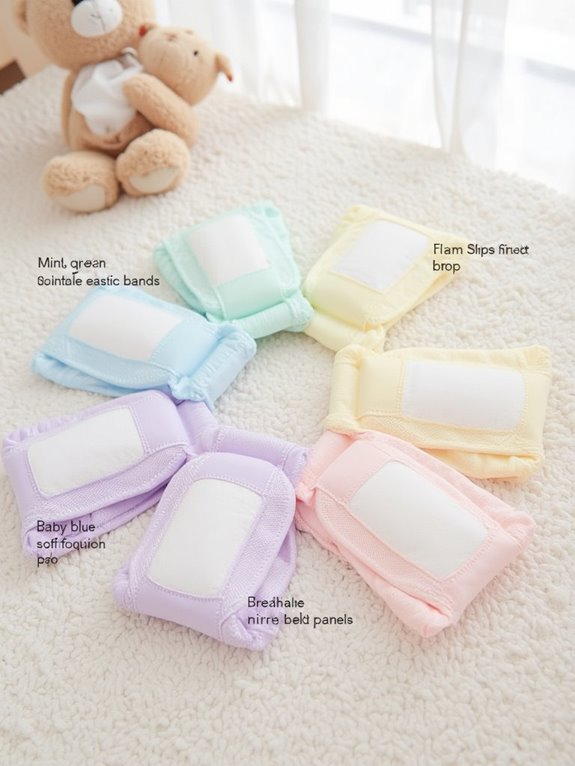Links below are affiliate links. We earn a commission on purchases at no extra cost to you. Although our opinions are based on curated research, we haven't used these products. Articles generated with AI.

The 3 Best Baby Foods of 2025, According to Pediatricians
According to pediatricians, the top baby foods for 2025 prioritize developmental stages and organic ingredients. Gerber Stage 2 Chicken and Gravy (10-Pack) offers essential nutrients with 20% daily zinc for babies 6+ months. Happy Baby Organics Stage 2 Pouches feature USDA-certified organic fruit and vegetable blends in convenient packaging. Plum Organics Stage 4 Toddler Pouches provide nutrient-rich options for 12+ month-olds with no added sugars. Below, you’ll discover key factors to guide your selection process.
Key Takeaways
- Happy Baby Organics Stage 2 Pouches lead pediatrician recommendations due to USDA-certified organic ingredients and balanced fruit-vegetable nutrition for 6+ months.
- Gerber Stage 2 provides essential nutrients with 20% daily zinc and 10% potassium, making it a trusted choice for babies starting solids.
- Plum Organics Stage 4 excels for toddlers 12+ months with nutrient-rich blends containing fruits, vegetables, dairy, and grains.
- All three brands prioritize developmental appropriateness with progressive textures from smooth purees to thicker blends for growing babies.
- These options feature convenient, resealable packaging with clear expiration dates extending into 2026, supporting safe long-term storage.
Gerber Stage 2 Chicken and Gravy Baby Food (10-Pack)
Gerber Stage 2, Chicken and Gravy Jar, Baby Food, Mealtime Poultry Puree, 10-Pack
- CONVENIENT BABY FOOD: Our Gerber Chicken and Gravy Jar is designed for ease and convenience. These jars of baby food are made in a portable and easy-to-store format for...
- NUTRITIOUS: This baby food chicken has 20% of the daily value of zinc and 10% of the daily value of potassium
- STAGE TWO: Our chicken and gravy jar is a stage two baby food jar. It has been designed for babies six months and older who are ready to explore new textures and flavors,...
Parents seeking reliable nutrition for babies 6 months and older will find Gerber Stage 2 Chicken and Gravy Baby Food an essential choice for introducing solid foods. This finely pureed chicken provides 20% of daily zinc and 10% of daily potassium values your baby needs.
Key Benefits:
- Tender, smooth texture perfect for early eaters
- No artificial colors or flavors
- Portable, convenient jars
- Made with wholesome ingredients
While the price point of $2.20 per jar is higher than some alternatives, you’re getting tested quality and safety standards from a trusted brand. The 10-pack format offers convenient storage and meal planning options for busy parents as they make the transition their infants to stage two foods.
Best For: Parents of babies 6+ months old who are beginning to explore solid foods and need a trusted, nutritious pureed chicken option for their infant’s developmental stage.
Pros:
- High-quality ingredients with no artificial colors or flavors
- Provides essential nutrients (20% daily zinc, 10% daily potassium)
- Convenient portable jars with smooth texture perfect for early eaters
Cons:
- Relatively expensive at $2.20 per jar
- Limited availability in some areas
- Small portion sizes may require multiple jars per feeding
Happy Baby Organics Stage 2 Baby Food Pouches (10 Pack, 4 oz)
Happy Baby Organics Stage 2 Baby Food Pouches, Gluten Free, Vegan & Healthy Snack, Clearly Crafted...
- Clearly Crafted: When it comes to caring for your baby, transparency is everything. That’s why we bring you Clearly Crafted. Our clear packaging lets you see the...
- Stage Two Eaters: Great for the exploratory taste buds of Stage 2 eaters, our Stage 2 baby foods and baby snacks introduce baby to simple balances of fruits and veggies...
- Happy Baby: We provide organic, delicious options for your baby's nutritional journey; Happy Baby offers baby food pouches, cereals, teething wafers, baby snacks and more...
Young eaters shifting to solid foods will find an ideal match in Happy Baby Organics Stage 2 Baby Food Pouches, which deliver USDA-certified organic ingredients in convenient 4-oz portions.
These gluten-free, vegan pouches feature transparent packaging that lets you see the vibrant purees inside. You’ll appreciate knowing exactly what your baby’s eating, with ingredients grown without toxic pesticides. The resealable caps help you store unused portions safely.
The 10-pack variety introduces your baby to balanced fruit and vegetable combinations, expertly blended to mask nutritious ingredients like kale and spinach while maintaining appealing flavors. With expiration dates extending into 2026, you’ll have plenty of time to use these pouches for snacks and meals.
Best For: Parents and caregivers of babies transitioning to solid foods who want convenient, organic, and nutritious food options for their little ones.
Pros:
- USDA-certified organic ingredients with transparent packaging showing visible contents
- Convenient resealable pouches perfect for on-the-go feeding
- Expertly blended combinations that make nutritious vegetables palatable for young eaters
Cons:
- Limited nutritional value for adults or older children seeking higher calories or protein
- Sugar content may be a concern for some parents
- More expensive than non-organic baby food alternatives
Plum Organics Stage 4 Toddler Food Pouches (18 Pack)
Plum Organics Stage 4 Variety Pack – Toddler’s Taste Adventure & Sunrise Pack – Mighty 4 &...
- PLUM TODDLER FOOD: Organic toddler food for 12 months and older; Perfect on the go snacks for kids
- MADE WITH NATURAL FLAVORS: Banana, Blueberry, Sweet Potato, Carrot, Greek Yogurt, and Millet, Strawberry, Banana, Greek Yogurt, Kale, Amaranth, and Oat, and Banana, Kiwi,...
- ORGANIC TODDLER SNACKS: USDA Organic Certified and Non-GMO blend of fruits, vegetables, dairy, and grains; Unsalted and unsweetened
For families seeking organic, nutrient-rich options for toddlers 12 months and older, Plum Organics Stage 4 Toddler Food Pouches offer an Amazon-exclusive 18-pack solution that prioritizes both convenience and nutrition.
These USDA Organic Certified pouches contain blends of fruits, vegetables, dairy, and grains without added salt or sugar. You’ll find varieties like Banana-Blueberry-Sweet Potato with Greek yogurt and Strawberry-Banana-Kale with amaranth. The 4-oz resealable pouches help reduce waste and simplify on-the-go feeding, though some thicker blends may be challenging for toddlers to extract. While convenient, consider balancing pouch use with traditional spoon-feeding to support proper feeding development.
Best For: Health-conscious parents seeking convenient, organic snack options for toddlers 12+ months who need portable, nutritious meals during busy days or travel.
Pros:
- USDA Organic certified ingredients with no added salt or sugar
- Convenient resealable pouches that reduce waste and are perfect for on-the-go feeding
- Diverse variety of nutrient-rich blends incorporating fruits, vegetables, grains, and dairy
Cons:
- Thicker blends can be difficult for some toddlers to extract from pouches
- May contribute to picky eating habits if overused instead of traditional spoon-feeding
- Higher cost compared to preparing fresh food at home
Factors to Consider When Choosing Baby Food

When selecting baby food for your little one, you’ll need to match the food stage with your child’s age and developmental readiness, while also weighing the benefits of organic versus conventional options. Your choice should factor in the nutritional content, including essential vitamins, minerals, and appropriate textures for your baby’s growth phase. Storage requirements, portion sizes, and cost per serving will help you determine which products offer the best value for your family’s needs.
Age-Appropriate Food Stages
Selecting age-appropriate baby food stages plays a crucial role in your child’s developmental journey and nutritional safety. You’ll need to match each stage with your baby’s specific age and eating abilities.
Key Stages to Follow:
- Stage 1 (0-4 months): Smooth, single-ingredient purees for newborns
- Stage 2 (4-6 months): Slightly textured foods for beginning solid food exploration
- Stage 3 (6-8 months): Smooth consistency with gradual texture introduction
- Stage 4+ (12+ months): Chunkier textures for developed chewing skills
These stages aren’t just guidelines—they’re designed to protect your baby from choking hazards while supporting their developing eating abilities. As you shift between stages, watch for signs that your baby’s ready to progress, such as improved head control and interest in more complex textures.
Organic Vs Regular Options
Parents steering the baby food aisle must weigh the differences between organic and regular options to make informed choices for their little ones. When comparing your options, consider these key factors:
Safety and Processing
- Organic foods contain no synthetic pesticides or fertilizers
- Regular options may include artificial preservatives and colors
- Organic certification requires strict compliance with farming standards
Nutritional Comparison
- Both types offer similar core nutrients
- Organic options may provide higher antioxidant levels
- Neither option guarantees superior nutritional value
Practical Considerations
- Organic foods typically cost 20-30% more
- Regular options offer wider availability
- Storage life may differ between choices
Remember that both organic and regular baby foods must meet FDA safety standards, so your choice should align with your budget, values, and accessibility needs.
Nutritional Value Assessment
Beyond the organic versus conventional debate lies the fundamental importance of nutritional content in your baby’s food. When evaluating options, you’ll need to carefully assess the vitamin and mineral content to guarantee it matches your little one’s developmental requirements.
Key factors to examine:
- Daily Value percentages of essential nutrients like iron, zinc, and potassium
- Presence of artificial additives, preservatives, or added sugars
- Quality and recognizability of ingredients listed
- Caloric density appropriate for your baby’s age
- Balance of macro and micronutrients
You’ll want to compare labels between products, focusing on those that offer complete nutrition without unnecessary fillers. Look for foods that contain naturally occurring vitamins rather than synthetic alternatives, and ensure the calorie content aligns with your pediatrician’s recommendations for your baby’s growth stage.
Storage and Convenience
While nutritional value remains paramount, the practical aspects of storage and convenience play a crucial role in choosing the right baby food for your family’s lifestyle. When selecting baby food products, you’ll want to prioritize packaging that fits seamlessly into your daily routine.
Look for these key convenience features:
- Resealable containers, especially pouches and jars, that you can easily transport
- Microwave and stove-safe packaging for quick heating options
- Extended shelf life with clearly marked expiration dates
- Compact, lightweight designs that maximize storage space
- User-friendly packaging that both parents and babies can handle safely
These practical considerations ensure you’ll have fresh, ready-to-serve food whenever your baby needs it. The right packaging can make feeding time more efficient while maintaining food safety and reducing waste.
Price and Package Size
Making smart financial decisions about baby food starts with understanding how package sizes affect overall value. You’ll want to weigh the convenience of smaller containers against the cost savings of bulk purchases.
Key Price Considerations:
- Compare unit prices across different package sizes
- Factor in storage capabilities for bulk options
- Calculate the true cost per serving
- Consider your baby’s feeding schedule
Package Size Options:
- Single-serve pouches: Portable but higher cost per ounce
- Standard jars (4-6 oz): Good balance of freshness and value
- Multi-packs: Better price point with moderate storage needs
- Bulk containers: Most economical but require proper storage
Premium organic varieties typically cost 20-30% more than conventional options, but buying larger quantities can help offset this price difference. Remember to account for your storage space and weekly usage when selecting package sizes.
Frequently Asked Questions
How Long Can Opened Baby Food Safely Stay in the Refrigerator?
You should store opened baby food in the refrigerator for no more than 48 hours. After opening a jar or pouch, transfer any unused portion to an airtight container and refrigerate immediately. Don’t feed your baby directly from the container, as this introduces bacteria. For homemade baby food, follow the same 48-hour rule. If you’re unsure whether stored food is still safe, it’s best to discard it.
Can I Warm Baby Food Pouches in the Microwave?
Ever wondered about the safest way to warm your baby’s food pouches? While it’s technically possible to microwave them, it’s not recommended. Here’s why:
- Microwaving creates hot spots that can burn your baby
- Heat distribution is uneven in pouches
- The pouch material may leach chemicals when heated
Instead, you should:
- Place the pouch in warm water for 1-2 minutes
- Test the temperature on your wrist before feeding
- Squeeze contents into a microwave-safe bowl if warming is necessary
At What Age Should I Stop Feeding My Baby Pureed Foods?
You should start shifting your baby from pureed foods to more textured foods between 8-10 months of age. Here’s what to contemplate:
- Your baby should show signs of readiness, like:
- Sitting without support
- Picking up food with fingers
- Making chewing motions
- Begin with soft, mashed foods before moving to finely chopped options
- Complete the transition by 12 months, when your baby should be eating mostly table foods
Remember: Every baby develops differently, so consult your pediatrician for personalized guidance.
What Signs Indicate My Baby Is Allergic to Certain Baby Foods?
Watch for these common signs of food allergies in your baby:
- Hives or skin rashes appearing within minutes to hours after eating
- Swelling around the face, especially lips and eyes
- Vomiting, diarrhea, or digestive issues
- Difficulty breathing or wheezing
- Excessive crying and irritability after meals
If you notice any of these symptoms, especially breathing problems, call your doctor immediately. Keep a food diary to track what your baby eats and any reactions that follow.
Can I Mix Breast Milk or Formula With Store-Bought Baby Food?
You can safely mix breast milk or formula with store-bought baby food. However, follow these key guidelines:
- Only mix what your baby will eat in one sitting
- Discard any leftover mixture after feeding
- Never save mixed portions for later use
- Keep breast milk/formula and baby food at the same temperature
- Don’t mix directly in baby food jars
This mixing technique helps thin out thicker foods and adds familiar flavors your baby already enjoys.







